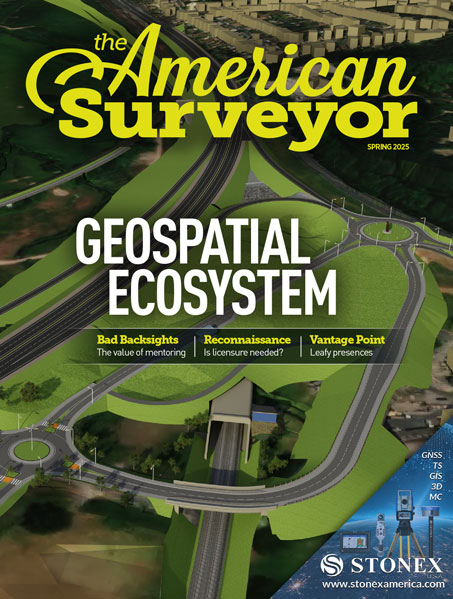Will GPS put surveyors out of work? Nationwide ALSA scholarships offered. ALSA buried facilities position paper.
With Global Positioning Systems (GPS) becoming more popular and more affordable, will they put the land surveyor out of work?
Ed and Frank each owned an acreage next to one another in rural Alberta. For years, they had talked about putting up a fence between their two properties and, this year, they finally decided to do it. They thought a hand-held Global Positioning System (GPS), with a readout to three decimal places, would show them where to put the fence. They were in for a big surprise!
Together, Ed and Frank went into town to the hardware store and purchased a hand-held GPS unit for $100. Ed dug out his land survey from twelve years ago and located the iron post that legally defines the boundary at the north end of the property. According to the survey, the iron post at the south end of the property should be 855 metres away. Ed and Frank walked along the property line together and were shocked to find the post was only 850 metres away. The land surveyor had made a mistake! Ed called the Alberta Land Surveyors’ Association to lodge a complaint against the land surveyor.
Today’s GPS is more accurate than it once was. It is a great tool to find your favorite fishing spot or even navigate your way around town in those new luxury cars but land owners usually want to know where their boundary is to the nearest centimetre.
Just because the unit displays three decimal places, it does not mean that it is accurate to three decimal places. GPS units can range in price from $100 to $50,000. Generally speaking, the more a GPS unit costs, the greater accuracy you will be able to achieve.
The Association advised Ed and Frank to hire an Alberta Land Surveyor to do a fence-line survey for them. The Alberta Land Surveyor will stake out where the fence should be placed and the land owners will be able to rely on the fact that the Alberta Land Surveyor has done the work in accordance with the appropriate legislation – usually for a small fraction of the price to put up the fence itself.
Alberta Land Surveyors Offer New Scholarships Nation-Wide
The Alberta Land Surveyors’ Association announced they are increasing the value of the scholarships they offer by more than 50% to $21,000 per year.
“I am pleased to announce,” reported Dirk VandenBrink, President of the Alberta Land Surveyors’ Association “that we are increasing the value of our scholarships at NAIT and SAIT to $1,500 per year and creating a new scholarship at Lethbridge Community College in the amount of $1,500 per year. We will also establish new scholarships of $1,000 each at BCIT, the Saskatchewan Institute of Applied Science and Technology, Red River College, Nova Scotia Community College, and the College of the North Atlantic.”
“Each of these schools,” continued President VandenBrink, “have produced successful geomatics graduates who have come to be employed in Alberta. The Alberta Land Surveyors’ Association wants to give something back to these schools for future graduates regardless of whether they ever work in Alberta or not.”
The Alberta Land Surveyors’ Association will continue to offer $2,500 scholarships to University of Calgary and University of New Brunswick geomatics students.
Land surveyors across Canada must be licensed by their local professional association in order to practice. In order to obtain a license, a person is typically a University of Calgary or University of New Brunswick geomatics graduate or have equivalent university-level education. Licensed land surveyors are assisted by technologists, many of whom have graduated from technical schools across Canada like NAIT, SAIT and Lethbridge Community College.
Alberta Land Surveyors Issue Buried Facilities Position Paper
The Alberta Land Surveyors’ Association released a position paper outlining issues and recommendations concerning the proliferation of buried facilities in Alberta and the need to be able to safely place boundary markers. The report is online at www.alsa.ab.ca/papers.htm.
“The Alberta Land Surveyors’ Association is concerned,” said President Dirk VandenBrink of the Alberta Land Surveyors’ Association,” that ground disturbance policies and the desire to prevent damage to buried facilities has affected the Alberta Land Surveyor’s ability to safely put the iron posts in the ground that mark boundary lines. Without these statutory monuments in place, there may be complaints by landowners and even the buried facility owners themselves as to the correct location of their property or rights-of-way.”
The report contains six recommendations including: lobbying the government, regulatory bodies and facility owners to develop a system to record the position of facilities as they are constructed; educating the government, regulatory bodies and facility owners as to the legislative requirement of the establishment and preservation of survey monuments; and recommending that land surveyors have buried facilities located and confirmed first.
Buried facilities include, but are not limited to, pipes, conduits, wires, cables, and fibre optics. Ground disturbance has become the preferred term to refer to excavation, digging, trenching and driving bars, posts, and anchors.
